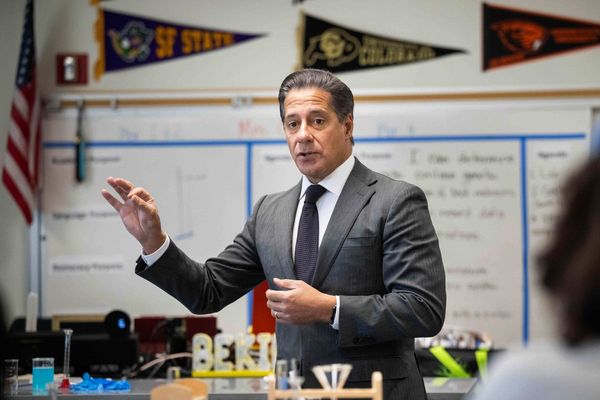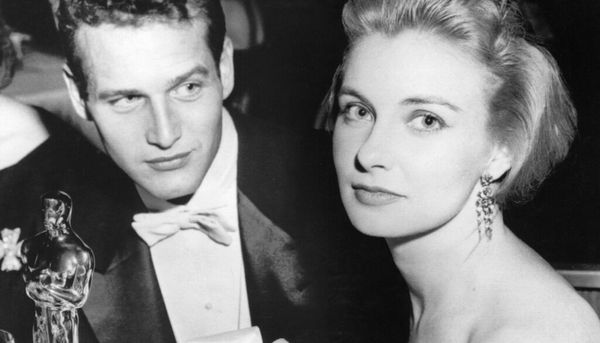Long before the line “Who are those guys?” became a running gag in “Butch Cassidy and the Sundance Kid,” the public wondered the same thing about Paul Newman and Joanne Woodward.
Millions knew them, especially him, without knowing anything about the inner workings of their partnership. Defined by the 15 films they made together, several with Newman directing his wife, they became the industry bench mark for relationship success. Other famous couples fell apart. They stayed coupled. “But it hasn’t been easy,” Woodward once told an interviewer. “I don’t think any valid relationship is.”
“The Last Movie Stars,” which premiered Thursday on HBO Max, does an extraordinary job of revealing the other side of the facade, without fawning or tidy summaries of judgment. It’s six of the most irresistible hours of TV I’ve seen this year.
Here’s the origin story. In the late 1980s, Newman began work on a memoir with screenwriter Stewart Stern. They recorded hundreds of hours of interviews with Newman and Woodward, their friends, co-workers and family members. They talked to directors (Elia Kazan, Sidney Lumet, Martin Ritt, George Roy Hill), famous actors and writers, non-famous people. A high school beau of Woodward’s, for example.
Newman soured on the book project. One day, he lit a match and burned the tapes — though not before they’d been transcribed on paper. Once Ethan Hawke looked at the transcripts, he knew he had a movie. He hired actors he knew to read some of the excerpts, in character.
Early on and then throughout “The Last Movie Stars,” we see Hawke in Zoom calls, mid-pandemic, explaining his approach to Laura Linney (who voices Woodward’s material), George Clooney (Newman) and a deep bench of an ensemble including Sally Field, Sam Rockwell, Oscar Isaac and on and on. There’s enough of Hawke talking about the project, while we’re watching the project, to court disaster. The director wants “The Last Movie Stars” to be a real-time account of his own filmmaking process, in addition to doing right by Newman and Woodward.
Inevitably there are moments when you think: OK, how about getting back to the subjects at hand? Miraculously, though, the six parts coalesce and build in wonderful ways. The episodes are expansive enough to accommodate everything Hawke (whose previous directorial work includes the beautiful “Seymour: An Introduction”) has on his mind. And foremost on his mind is his fascination with two fascinating enigmas, here — gratifyingly — made a little less enigmatic.
Amplifying the treasure trove of audio transcripts, “The Last Movie Stars” draws from a wealth of existing film and still footage of Newman and Woodward, across the decades. (Woodward is still with us; Newman died in 2008.) At the formidable training ground the Actors Studio, Newman, from Shaker Heights, Ohio, felt utterly outclassed by wild hares such as Marlon Brando, James Dean, Ben Gazzara, Rip Torn. They were all “confidence and energy … without oratory, without ‘acting.’”
Woodward, hailing from Thomasville, Georgia, was accepted into the Actors Studio ranks soon enough. They both got hired for William Inge’s demurely sultry drama “Picnic,” premiering on Broadway in 1953. Newman played the milquetoast country club denizen Alan, though he yearned to play the studly Hal and eventually replaced Ralph Meeker in the leading role.
Understudying Hal, he’d practice the sexy dance duet with his fellow understudy, Woodward, in the wings during performances. They couldn’t keep their hands off each other. Newman’s wife and three kids eventually found out what was going on, years later. In the documentary, Newman’s daughter, Stephanie, says she felt “disgusted” by her father. But she adds: disgust was “not the only feeling.”
Woodward married Newman in 1958, a few months before they were paired on screen in “The Long Hot Summer.” That film, which came out just before Newman co-starred with Elizabeth Taylor in “Cat on a Hot Tin Roof,” cemented Newman’s blue eyes and sweaty torso in the eyes of an avid public. Woodward’s appeal wasn’t the same. Neither was her range or her unvarnished authenticity. She knew who she was, and how to play who she wasn’t. Newman was more cautious by temperament, and by talent. At one point Clooney-as-Newman confesses to feeling like “a collection of old characters (I’ve) played,” strung together “into a kind of a human being.”
For Newman, the early, unflattering comparisons to Brando and James Dean were a lot to ignore. His luck, which he says began by “being born white in America in 1925,” continued when he got his big break in movies as Rocky Graziano in “Somebody Up There Likes Me” (1956). He landed the role only because Dean, originally cast, died in a car accident.
“His equipment emotionally was average,” director Martin Ritt says at one point in the documentary. “Or less than average.” But he worked hard and improved, and by the time of “The Hustler,” “Hud” and “Cool Hand Luke,” Newman had become his own kind of movie star.
Director Hawke addresses Newman’s probable alcoholism (nothing “probable” about it, according to at least two of his kids), and, more obliquely, an affair that coincided with Newman’s self-admitted low point and heaviest booze intake. All of this comes out, and through, the subjects in “The Last Movie Stars” as parts of a whole. Hawke’s editor Barry Poltermann is a wizard at intertwining newsreel footage; stills (at one point we see Newman in the back seat of a limo with an uncredited Roger Ebert); Zoom screens; and judiciously chosen examples of Newman and Woodward’s screen careers, from early live TV to “Mr. and Mrs. Bridge” (1990).
To Newman, Woodward was the real actor in the family, not a faker or pretender like he was. She made it big far sooner than he did, winning the Academy Award for best actress for “The Three Faces of Eve” (1957). Then she back-burnered her own career to raise their three children, in addition to the three from Newman’s first union. “If I had to do it all over again,” Linney (as Woodward) says at one point, “I might not have had children.”
Private correspondence between Paul and Joanne brings out a hushed, intimate quality of confession in the marriage. “I miss you,” Woodward writes to Newman at one point. “I don’t know who you are. But I miss you anyway. I just wish you were happy, and that you could say what you feel, not just what you think.” You don’t have to be Joanne Woodward or Paul Newman to recognize the emotional terrain of that landscape. “The Last Movie Stars” is more than a mash note; it’s a triumph of movie love as well as an incisive exploration of two utterly different personalities who made perfect imperfect sense together.
———
'THE LAST MOVIE STARS'
4 stars (out of 4)
Rating: TV-MA (language)
Running time: Six episodes, approximately six hours
How to watch: All episodes premiered Thursday on HBO Max
———










